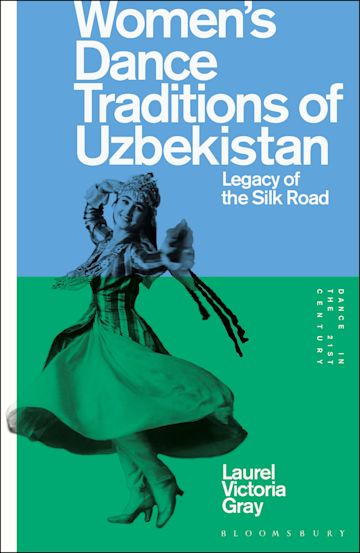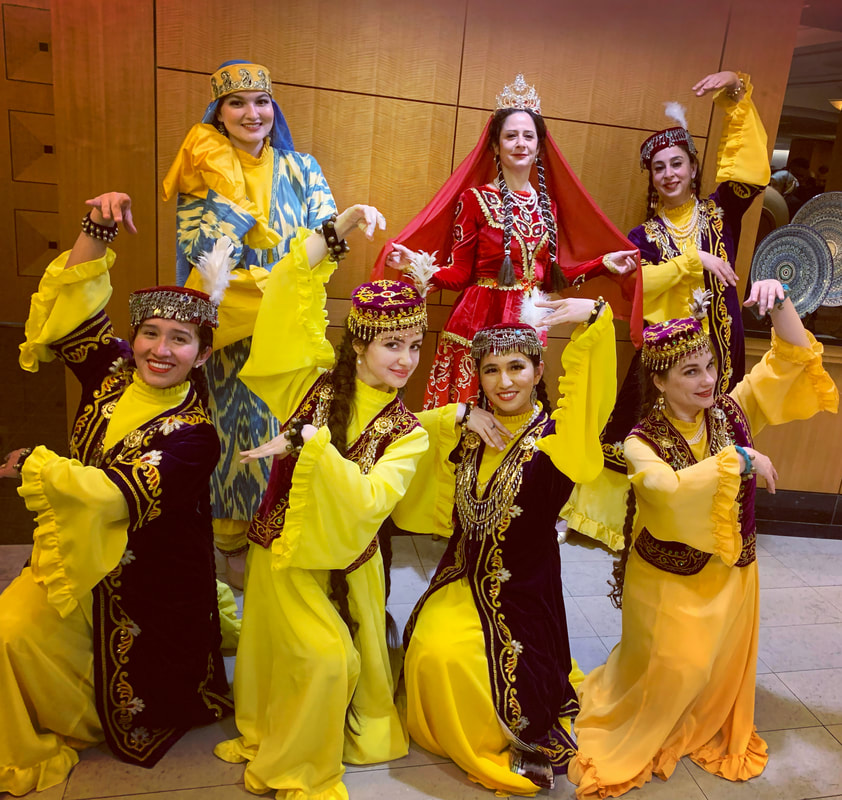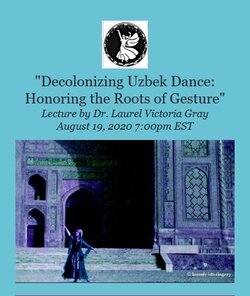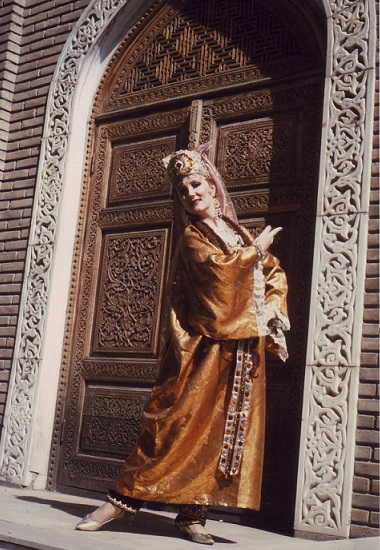Dances of the Silk Road & Beyond
CASA Celebrates Central Asian Awareness Day

Professor Emeritus Michael Brown introduces Laurel Victoria Gray CASA Celebrates Central Asian Awareness Day Skylar Lewis, Guest Writer University of Wyoming, Laramie, Wyoming Tuesday, April 23, 2024 As part of the University of Wyoming Central Asian Student Association (CASA) Central Asian Awareness Day and Navruz celebrations, the renowned choreographer, dance scholar and founder of the award-winning Silk Road Dance Company, Dr. Laurel Victoria Gray, also referred to as “the pioneer of Uzbek dance in America,” was invited to UW's campus for two days of presentations and performances from the Silk Road Dance Ensemble. Michael R. Brown, the UW Emeritus Communications and Journalism professor, who has been working with students and professionals from Kazakhstan since 2012, spoke on the significance of Dr. Gray's work in Central Asia. “Uzbekistan was at the crossroads of the Silk Road with influence from Turks, Persians, Arabs, Chinese, Uyghurs and Russians, among others. While many Americans may not be familiar with this part of the world, to have an opportunity to work in this part of the world and share it as both very interesting and very important.” “Dr. Gray's work has received international recognition by the most important academic and cultural organizations who honor dance... she has been named Honorary Professor at the Uzbekistan State Institution of Arts and Culture, invited to participate in Uzbekistan's State Academic Bolshoi Theater, participated in UNESCO's Sharq Taronalari Festival in Samarkand, honored by the Ministry of Culture in Uzbekistan,” and received a Distinguished Service Award from the Embassy of Uzbekistan,” Brown said. “To be honored by the culture you represent is the highest honor, and a true indication of honesty, accuracy, and high achievement in her work to understand Uzbek dance,” he said. On Thursday, Dr. Gray took to the Coe Library to not only give a detailed lecture about the long, and at times suppressed, history of dance in Uzbekistan, but also to announce the official publishing of her book, Women's Dance Traditions of Uzbekistan: Legacy of the Silk Road, of which free copies and signings were offered to the attendees present at the lecture. Dr. Gray's presentation illustrated a brief timeline of how this cultural aspect of the Uzbek people, particularly Uzbek women, came to manifest itself, the challenges that women faced and overcame to perform this art in public. While the lecture gave a more encompassing view of the region's history, Dr. Gray's book offers a much more comprehensive overview and further insight into the social into the political, social and cultural aspects of the Silk Road region that calls itself home to Uzbek dance. Friday featured a set of related events from Dr. Gray, her Silk Road Dance Ensemble and well-known dancer and musician, Zamira Salim, as part of CASA's 12th annual Navruz celebration, an event or festival which normally falls on or around March 21 and is widely celebrated in many Central Asian countries like Uzbekistan as the beginning of spring, or the vernal equinox commences. The event was hosted in the Wyoming Union ballroom, and had an impressive turnout, with nearly every seat being taken up by its attendees. Excited to see a live performance of Uzbek dance, and share a free meal in turn. After some short introductions from CASA’s student president, and Brown, as well as an opening performance from Salim, Dr. Gray introduced herself, her dancers, as well as some of the historical context for their performances, the first of which Dr. Gray introduced as “Kara Jorga,” or “Black Stallion.” “Greetings dear guests, dear friends,” Gray said. “We're going to take you on a whirlwind tour of Central Asia through dance and the very first place we are going into is Kurdistan [actually Kyrgyzstan], which may seem far away with nothing in common with Wyoming, but you would be wrong because I've seen all the equestrian statues in this town. So we brought you some horses, well actually, horseback riders.” Following the performances of Salm, Dr. Gray’s Silk Road dancers who performed “Black Stallion” and a solo traditional Uzbek dance for attendees, was a short intermission as organizers of the event began to call up tables to serve a traditional Central Asian style dinner, which was provided to the event by one of its sponsors, Thai Spice. As attendees enjoyed the food and company of others, they were offered consistent entertainment through the rest of the Navruz celebration as the Silk Road Dance Ensemble continued to perform several cultural dances for the crowd until the event’s end. As part of the University of Wyoming Central Asian Student Association (CASA) Central Asian Awareness Day and Navruz celebrations, the renowned choreographer, dance scholar and founder of the award-winning Silk Road Dance Company, Dr. Laurel Victoria Gray, also referred to as “the pioneer of Uzbek dance in America,” was invited to UW's campus for two days of presentations and performances from the Silk Road Dance Ensemble. Michael R. Brown, the UW Emeritus Communications and Journalism professor, who has been working with students and professionals from Kazakhstan since 2012, spoke on the significance of Dr. Gray's work in Central Asia. “Uzbekistan was at the crossroads of the Silk Road with influence from Turks, Persians, Arabs, Chinese, Uyghurs and Russians, among others. While many Americans may not be familiar with this part of the world, to have an opportunity to work in this part of the world and share it as both very interesting and very important.” “Dr. Gray's work has received international recognition by the most important academic and cultural organizations who honor dance... she has been named Honorary Professor at the Uzbekistan State Institution of Arts and Culture, invited to participate in Uzbekistan's State Academic Bolshoi Theater, participated in UNESCO's Sharq Taronalari Festival in Samarkand, honored by the Ministry of Culture in Uzbekistan,” and received a Distinguished Service Award from the Embassy of Uzbekistan,” Brown said. “To be honored by the culture you represent is the highest honor, and a true indication of honesty, accuracy, and high achievement in her work to understand Uzbek dance,” he said. On Thursday, Dr. Gray took to the Coe Library to not only give a detailed lecture about the long, and at times suppressed, history of dance in Uzbekistan, but also to announce the official publishing of her book, Women's Dance Traditions of Uzbekistan: Legacy of the Silk Road, of which free copies and signings were offered to the attendees present at the lecture. Dr. Gray's presentation illustrated a brief timeline of how this cultural aspect of the Uzbek people, particularly Uzbek women, came to manifest itself, the challenges that women faced and overcame to perform this art in public. While the lecture gave a more encompassing view of the region's history, Dr. Gray's book offers a much more comprehensive overview and further insight into the social into the political, social and cultural aspects of the Silk Road region that calls itself home to Uzbek dance. Friday featured a set of related events from Dr. Gray, her Silk Road Dance Ensemble and well-known dancer and musician, Zamira Salim, as part of CASA's 12th annual Navruz celebration, an event or festival which normally falls on or around March 21 and is widely celebrated in many Central Asian countries like Uzbekistan as the beginning of spring, or the vernal equinox commences. The event was hosted in the Wyoming Union ballroom, and had an impressive turnout, with nearly every seat being taken up by its attendees. Excited to see a live performance of Uzbek dance, and share a free meal in turn. After some short introductions from CASA’s student president, and Brown, as well as an opening performance from Salim, Dr. Gray introduced herself, her dancers, as well as some of the historical context for their performances, the first of which Dr. Gray introduced as “Kara Jorga,” or “Black Stallion.” “Greetings dear guests, dear friends,” Gray said. “We're going to take you on a whirlwind tour of Central Asia through dance and the very first place we are going into is Kurdistan [actually Kyrgyzstan], which may seem far away with nothing in common with Wyoming, but you would be wrong because I've seen all the equestrian statues in this town. So we brought you some horses, well actually, horseback riders.” Following the performances of Salm, Dr. Gray’s Silk Road dancers who performed “Black Stallion” and a solo traditional Uzbek dance for attendees, was a short intermission as organizers of the event began to call up tables to serve a traditional Central Asian style dinner, which was provided to the event by one of its sponsors, Thai Spice. As attendees enjoyed the food and company of others, they were offered consistent entertainment through the rest of the Navruz celebration as the Silk Road Dance Ensemble continued to perform several cultural dances for the crowd until the event’s end. NEW RELEASE!
|
Uzbek Government Honors
|
|
|
|




















































